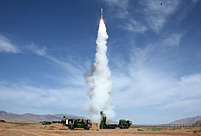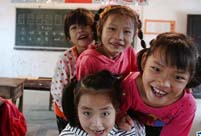 |
| (hinews.cn) |
The "Pan-Pearl River Delta Region" concept was first proposed by Zhang Dejiang, Chinese vice premier and former Secretary of the CPC Committee of Guangdong Province, at the 2003 International Conference on the Economic Development of Guangdong Province. The proposal received a positive response from the provincial governments of Fujian, Jiangxi, Hunan, Guangxi, Hainan, Sichuan, Guizhou and Yunnan.
On June 3, 2004, the governments of the nine provinces and the two special administrative regions (Hong Kong and Macao) signed the Pan-Pearl River Delta Regional Co-operation Framework Agreement in Guangzhou.
The "Pan-Pearl River Delta Region" includes nine provinces–Guangdong, Fujian, Jiangxi, Hunan, Guangxi, Hainan, Sichuan, Guizhou and Yunnan–plus two special administrative regions – Hong Kong and Macao–creating the regional structure that is sometimes referred to as "9+2".
The "Pan Pearl River Delta Regional Co-operation Framework Agreement" laid a firm foundation for future co-operation in the area of infrastructure, industries and investment, commerce and trade, tourism, agriculture, labour, education and culture, information system, environmental protection and health and quarantine. Parties of the agreement agreed to establish multi leveled regional co-operation including a system of meetings between the executive heads of various administrative regions.
The prospect of the Pan-Pearl River Delta tourism cooperation is mainly embodied in the common goals. Accessible transportation: to build a thorough traffic network system, traffic signal system, traffic information system, and enable tourists to travel without barriers in each cooperative region; accessible market: to remove market barriers, mutually open markets for tourism investment; to build a platform for market promotion; to put mechanisms in place to monitor and coordinate the tourism market, to treat local industry and industry from cooperative region equally, to achieve regional tourism market integration; accessible information: to build a unified information network, to establish a long-lasting channel for communication, to achieve information sharing and to build a unified, open and efficient tourism e-commerce service platform; accessible administration: to promote the construction of a management organization, to draw up policies to facilitate tourism cooperation, to remove systematic and administrative barriers, and to reconcile all the problems and conflicts which appears in cooperation. To set up a early warning mechanism and an important event notification system during golden weeks and important festivals; to strengthen industrial management and market surveillance, to regulate the order of tourism industry, to cultivate a good image, to put mechanisms in place to monitor and coordinate the tourism market, to fight against operations that disrupt market order; to create a good external environment for industries to have a multi-azimuth, multi-layered tourism cooperation.
 National Plug In Day celebrated in Washington D.C.
National Plug In Day celebrated in Washington D.C. New model of indigenous surface-to-air missiles testfired
New model of indigenous surface-to-air missiles testfired  118.28-carat diamond to be auctioned in HK
118.28-carat diamond to be auctioned in HK Maternal love under streetlight
Maternal love under streetlight Naked foreign student sits in the middle of a road in Haikou
Naked foreign student sits in the middle of a road in Haikou  Colorful Yunnan: Enjoy the natural beauty
Colorful Yunnan: Enjoy the natural beauty Harbin named Chinese city with most beautiful women
Harbin named Chinese city with most beautiful women For last four students, teacher couple sticks to post on island
For last four students, teacher couple sticks to post on island  When big sport stars were kids
When big sport stars were kids PLA's 38th Group Army conduct training
PLA's 38th Group Army conduct training People mourn for victims of mall attack
People mourn for victims of mall attack The last days of Wan Aihua
The last days of Wan Aihua Highlights at 12th National Games of China
Highlights at 12th National Games of China Beijing Film Academy welcomes freshmen
Beijing Film Academy welcomes freshmen Large mahjong party sets new world record
Large mahjong party sets new world recordDay|Week|Month